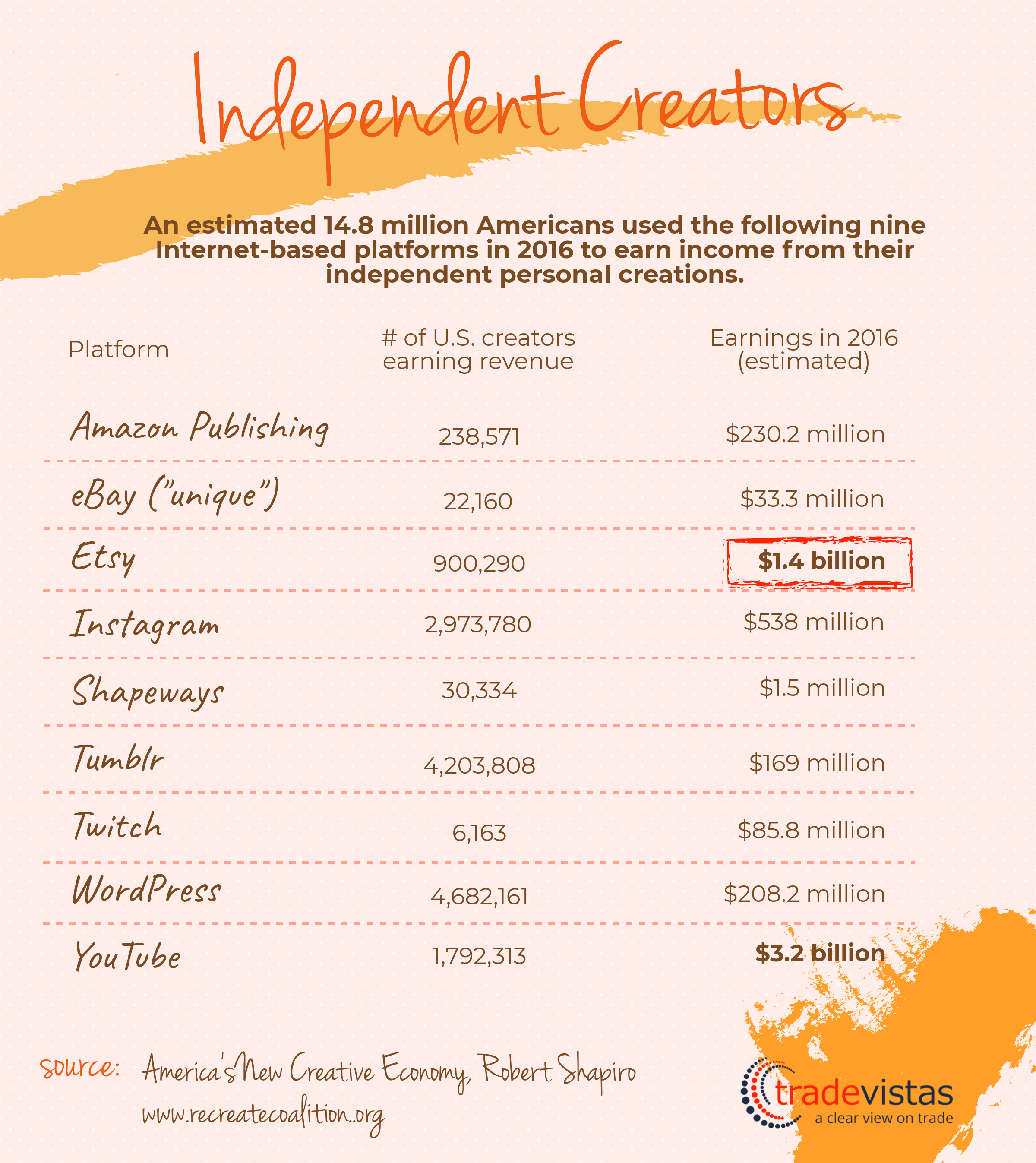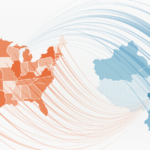This Feels Personal
Etsy is an online marketplace for handmade, vintage, or other unique items. The platform has 1.9 million active sellers, but it feels personal. Sellers are mostly individuals with real names, appealing personalities, and often charming back stories about how they started their businesses and what inspires their artistry. Shoppers can easily communicate directly with the creators, and buyers often feel good about supporting a small business. Last year 31.7 million buyers sought out crafts on Etsy, representing 16 percent year on year growth.
Who sells on Etsy? According to Etsy’s 2017 U.S. Seller Census, 87 percent are women. Twenty-eight percent live in rural communities. Ninety-seven percent run their shops from home, but for more than a third, their Etsy business is not a side-gig or a hobby; it’s their sole occupation. Etsy reports there’s an active seller in 99.9% of all the counties in the United States, and Etsy has steadily become a platform for creators all over the world.
“We build local marketplaces globally”
Etsy is a global business selling the concept of buying local. Last year, $1.4 billion in goods were bought and sold globally on Etsy’s platform, making it one of the most important Internet e-commerce sites for individuals and microenterprises.
The company’s main goals are…building local marketplaces globally, and…expanding the Etsy economy. — CEO Chad Dickerson
Nearly a third of the company’s gross merchandise sales comes from foreign countries, but Etsy goes out of its way to ensure buyers can easily find local vendors. Etsy’s approach includes making domestic shops more prominent in search results, creating special themes pages on its site to highlight local trends, and offering an “Etsy Local” option within its app. As the platform attracted more global sellers, Etsy began providing payment options more prevalent in other countries, translating listings into shoppers’ native languages, and partnering to put on “Etsy Made Local” events. All of these initiatives – they say – makes it easier for sellers to connect with buyers in their own countries.
Global-Sized Growing Pains
While there’s a lure for buyers to shop for unique products crafted in other countries, it can be difficult for very small businesses to navigate the requirements of international sales transactions. Etsy has created location-based seller teams in countries around the world so that microentrepreneurs can share insights and support one another.
Among the issues they are encouraged to discuss are how to navigate differences in tax requirements and managing shipping costs. Etsy surveys reveal that 22 percent of its sellers with customers in other countries report frustrations with understanding customs fees and tariffs. Thirty-five percent reported difficulties obtaining accurate tracking information, and many worry about meeting different sets of consumer protection regulations that apply to apply to their products when selling in other countries.
Staying “Local” When Your Business is Global
For Etsy to grow, its community of artisans must grow their own sales. It’s a good problem, but a problem nonetheless if sales take off before a creator has the capacity to meet production demand. Before 2013, Etsy would not allow its sellers to use outside manufacturers, which was seen as undermining its brand as a marketplace for local, handcrafted goods.
But in 2017, the company launched Etsy Manufacturing, an online hub where sellers can find manufacturers to help them scale production. Etsy still insists that creation begin with its sellers and says it only connects sellers with manufacturers that share its values of craftsmanship. Etsy requires that sellers remain closely involved and ultimately responsible for the integrity of their products even if they are not all personally handmade. There’s no right or wrong here. But the tale of Etsy’s own growth, and the need of its small sellers to scale production in response to global demand, demonstrate that in today’s economy, local can be truly global.
Gateway to the Creative Economy
More than half of Etsy’s revenue comes from the services they offer their 1.7 million sellers, which include helping sellers customize their websites, advertise, take secure payment, ship, and even scale production. Etsy’s services directly support sellers on the Etsy platform, but they also help sellers achieve success off of the Etsy platform. While Etsy and eBay may be the platforms of choice for handmade crafts, there are many Internet-based platforms for independent creators of all types (clothes, music, paintings, furniture) to showcase and sell their works. Internet platforms such as WordPress, YouTube, and Instagram serve as gateways for small companies to sell their products on the world stage.
The Recreate Coalition published a study last year called Unlocking the Gates: America’s New Creative Economy, in which the authors calculate that nearly 15 million Americans used nine platforms in 2016 to earn income from their independent personal creations. They included Amazon Publishing, eBay, Etsy, Shapeways, Twitch, and YouTube. The three Internet-based platforms with the largest number of users were Instagram with nearly 3 million users, Tumblr with 4.2 million users, and WordPress with 4.68 million users.

Capitalism, Wool Slippers, and Trade
The Recreate Coalition study suggests that independent creators earned an estimated $5.9 billion in 2016 from selling their creations through these nine platforms — and that’s just American creators. Millions more creators are doing the same around the world.
They include Inga from Vilnius, Lithuania who started BureBureSlippers. She hand makes felted wool slippers for women, men, and kids. In her profile, Inga explains, “I grew up in a country where people built buildings which looked exactly the same, worn [sic] clothes and hairstyles, which never went out of fashion, and bought boring grey shoes, because this was the only model produced in state factories.”
Her desire to produce something more beautiful for her countrymen to wear on their feet inspired her to begin crafting shoes with the support of her family. She says, “we are the only wool artisans in our small country using raw unwashed unpainted wool material produced in our own small sheep farm, but some part of wool and another material is purchased from abroad.” Inga discloses that she purchases a third of her wool materials from European sheep breeders and also has suppliers in Australia and New Zealand.
She has made 3,854 sales on Etsy at the time of this writing, and boasts 17,804 admirers — it’s a sure bet there are Americans right now walking around in her wool slippers.






